Permafrost Degradation within Eastern Chukotka CALM Sites in the 21st Century Based on CMIP5 Climate Models
Abstract
:1. Introduction
2. Study Area
2.1. Natural Conditions of Eastern Chukotka
2.2. Active Layer Monitoring Sites
3. Materials and Methods
3.1. Field Data
3.2. Climate Data
3.2.1. Observation and Reanalysis Data
3.2.2. CMIP5 Project Data
3.3. Seasonal Thaw Models
3.3.1. Regression Model
3.3.2. The Stefan Model
3.3.3. Kudryavtsev Model
3.4. Thaw Subsidence Model
4. Results
4.1. Weather Characteristics, ALT and Thaw Subsidence Contemporary Variations
4.2. Active Layer Modeling
4.2.1. Regression Model
4.2.2. Stefan Model
4.2.3. Kudryavtsev Model
- Soil characteristics of ALT for the Lorino site were used from an engineering survey report along the Lavrentiya-Lorino road, which is 50–300 m from both CALM sites (See Figure 2). Surveys were conducted in 2012 by the company Irkutskgiprodornii, and the report was kindly provided by the administration of the Chukotka administrative district. In order to estimate interannual variability of soil moisture, we compared the results of surficial soil moisture measurements within Lorino CALM site for 2011–2017. Averaged value was 52.2 ± 4.9% with 12.9% spread that was estimated as relatively stable parameter in time. Thus, we considered it possible to use data from engineering surveys in 2012. The required soil parameters are presented in Table 6.
- Mean annual permafrost surface temperature (Tps) for both sites was retrieved from the data logger readings installed on the CALM Lavrentiya site for the period 2014–2017.
- Amplitude of annual periodic temperature variations at the ground surface (Ags) is the average difference over several years in maximum and minimum mean monthly temperatures of the soil surface [43]. For our calculations it was defined as the difference between mean annual ground surface temperature (MAGST) and the average temperature of the soil surface in the warmest month (usually July or August).
- MAGST was also determined from data loggers at the Lavrentiya site.
- To calculate the thawing depth in the years when temperature observations were not carried out, the average temperature of the soil surface in the warmest month of the year was calculated taking into account the average monthly air temperature. According to data loggers measurements, these characteristics turned out to be approximately equal at this time of year.
- MAPST values were assumed as constant for the entire observation period.
4.2.4. Comparison of Measured and Modeled ALT Data
4.3. Predicted Climate Change for Eastern Chukotka Region
4.4. ALT Dynamics Estimation for 21st Century
4.5. Thaw Subsidence Dynamics for 21st Century
5. Discussion
5.1. Research Challenges
5.2. The Consequences of ALT Increase
5.2.1. Taliks Formation
5.2.2. Thaw Subsidence
5.3. Research Prospects
6. Conclusions
- Modeling of climatic parameters in the Chukotka region is associated with large uncertainties, probably caused by a lack of direct observations. The RMSE of the historical part of the ensemble of CMIP5 models and reanalysis is 7–20% for air temperatures and 22–33% for precipitation amounts. Thus, the climate in the study region is characterized by a wide range of possible values, that means that further calculations of ALT and thaw subsidence will be inaccurate. At the same time, the CMIP5 models ensemble reproduces some decadal fluctuations in air temperature (winter temperatures increase in the late 1990s—early 2000s, cooling from 2007, the general summer fluctuations). CMIP5 does not reproduce decadal fluctuations in the precipitation amount. In this case we can talk about the reproduction of mean annual (50–100 years) precipitation and use this data in construction of climate projections and the ALT. Based on CMIP5 climate reproduction, we should expect an increase in winter and summer temperatures and winter precipitation amounts in the 21st century. Under the positive scenario (RCP2.6), this growth will stop by 2050, under the negative one (RCP 8.5)—freezing and thawing indexes, precipitation amount in warm and cold periods will increase by 50−100% by the end of the century.
- The depth of seasonal thawing at the CALM sites Lavrentiya and Lorino, representing the natural conditions of the coastal plains of Eastern Chukotka, will increase by 6–13% by the end of the 21st century with a RCP 2.6 and by 43–87% with RCP 8.5.
- Active layer thickening will lead to irreversible surface subsidence, caused by permafrost thawing and ground ice melting. Under the RCP 2.6 climate scenario, the rate of surface lowering will be on average 0.4–1.5 cm·a−1, and under RCP 8.5 1.6–3.7 cm·a−1 (maximum 6.7 cm·a−1) throughout the 21st century. Relative total settlement values by the end of the century will be 50–130% of the current ALT under the RCP 2.6 scenario to 300–500% of ALT under the RCP 8.5 scenario. The deposits of massive ice beds found near and at the CALM Lavrentiya site can trigger the formation of cryogenic erosional landforms, in particular, thaw slumps. According to various estimates, this can occur in the time interval from 2039 to 2085 depending on the model used for seasonal thawing and climate change scenarios.
- Both ALT increment and thaw subsidence will lead to a lowering of permafrost table. Depending on the natural conditions, the calculation approach and the climate change scenario, the total decline will have been from 150 to 310 cm by the end of the 21st century, and the main contribution to this process will be made by sediment thawing.
- Apparently, the formation of taliks due to the active layer thickening (non-merging permafrost) over the 21st century will not occur under any climate change scenario; however, at the RCP 8.5 scenario, the model spread for predicted ALT exceeds the values of potential seasonal freezing.
- The seasonal thawing models used in the article vary in plausibility and, as a result, give different predictive estimates. To increase the predictive accuracy, it is necessary to continue and expand monitoring observations of the parameters to determine the thermophysical properties of soil surface, seasonally thawing layer and the upper horizons of permafrost at the CALM sites as well as identify the influence of climatic characteristics on these properties. Another straightforward solution to improve the presented results is introducing numerical permafrost models.
Author Contributions
Funding
Acknowledgments
Conflicts of Interest
References
- Brown, R. The Distribution of Permafrost and Its Relation to Air Temperature in Canada and the U.S.S.R. ARCTIC 1960, 13, 163–177. [Google Scholar] [CrossRef]
- Brown, J.; Ferrians, O.J., Jr.; Heginbottom, J.A.; Melnikov, E.S. Circum-Arctic Map of Permafrost and Ground-Ice Conditions; US Geological Survey: Reston, VA, USA, 1997; p. 45.
- Kudryavtsev, V.A.; Dostovalov, B.N.; Romanovsky, N.N. General Geocryology; Publishing house MSU: Moscow, Russia, 1978; p. 464. (In Russian) [Google Scholar]
- Streletskiy, D.A.; Tananaev, N.I.; Opel, T.; Shiklomanov, N.I.; Nyland, K.E.; Streletskaya, I.D.; Shiklomanov, A.I. Permafrost hydrology in changing climatic conditions: Seasonal variability of stable isotope composition in rivers in discontinuous permafrost. Environ. Res. Lett. 2015, 10, 095003. [Google Scholar] [CrossRef]
- Schuur, E.A.G.; Bockheim, J.; Canadell, J.G.; Euskirchen, E.; Field, C.B.; Goryachkin, S.V.; Hagemann, S.; Kuhry, P.; LaFleur, P.M.; Lee, H.; et al. Vulnerability of Permafrost Carbon to Climate Change: Implications for the Global Carbon Cycle. BioScience 2008, 58, 701–714. [Google Scholar] [CrossRef]
- Pavlov, A.V. Heat Exchange of Freezing and Thawing Grounds with the Atmosphere; Nauka: Moscow, Russia, 1965; p. 254. (In Russian) [Google Scholar]
- Pavlov, A.V.; Gravis, G.F. Vechnaya merzlota i sovremennyy klimat [Permafrost and the modern climate]. Priroda 2000, 4, 10–17. [Google Scholar]
- Kokelj, S.V.; Jorgenson, M.T. Advances in thermokarst research. Permafr. Periglac. Process. 2013, 24, 108–119. [Google Scholar] [CrossRef]
- Shur, Y.L. The Upper Horizon of Permafrost and Thermokarst; Nauka: Novosibirsk, Russia, 1988; p. 209. (In Russian) [Google Scholar]
- Hinkel, K.M.; Nelson, F.E. Spatial and temporal patterns of active layer thickness at Circumpolar Active Layer Monitoring (CALM) sites in northern Alaska, 1995–2000. J. Geophys. Res. Biogeosci. 2003, 108. [Google Scholar] [CrossRef]
- Shur, Y.L.; Jorgenson, M.T. Patterns of permafrost formation and degradation in relation to climate and ecosystems. Permafr. Periglac. Process. 2007, 18, 7–19. [Google Scholar] [CrossRef]
- Jorgenson, M.T.; Romanovsky, V.; Harden, J.; Shur, Y.; O’Donnell, J.; Schuur, E.A.; Kanevskiy, M.; Marchenko, S. Resilience and vulnerability of permafrost to climate change. Can. J. Forest Res. 2010, 40, 1219–1236. [Google Scholar] [CrossRef]
- Hjort, J.; Karjalainen, O.; Aalto, J.; Westermann, S.; Romanovsky, V.E.; Nelson, F.E.; Etzelmüller, B.; Luoto, M. Degrading permafrost puts Arctic infrastructure at risk by mid-century. Nat. Commun. 2018, 9, 5147. [Google Scholar] [CrossRef] [PubMed]
- Shiklomanov, N.I.; Streletskiy, D.A.; Swales, T.B.; Kokorev, V.A. Climate change and stability of urban infrastructure in Russian permafrost regions: Prognostic assessment based on GCM climate projections. Geogr. Rev. 2017, 107, 125–142. [Google Scholar] [CrossRef]
- Streletskiy, D.A.; Shiklomanov, N.I.; Nelson, F.E. Permafrost, Infrastructure, and Climate Change: A GIS-Based Landscape Approach to Geotechnical Modeling. Arct. Antarct. Alp. 2012, 44, 368–380. [Google Scholar] [CrossRef] [Green Version]
- Aalto, J.; Karjalainen, O.; Hjort, J.; Luoto, M. Statistical Forecasting of Current and Future Circum-Arctic Ground Temperatures and Active Layer Thickness. Geophys. Lett. 2018, 45, 4889–4898. [Google Scholar] [CrossRef] [Green Version]
- Streletskiy, D.A.; Shiklomanov, N.I.; Nelson, F.E. Spatial variability of permafrost active-layer thickness under contemporary and projected climate in Northern Alaska. Polar Geogr. 2012, 35, 95–116. [Google Scholar] [CrossRef]
- Nicolsky, D.J.; Romanovsky, V.E.; Panda, S.K.; Marchenko, S.S.; Muskett, R.R. Applicability of the ecosystem type approach to model permafrost dynamics across the Alaska North Slope. J. Geophys. Res. Earth Surf. 2017, 122, 50–75. [Google Scholar] [CrossRef]
- Zhang, Y.; Li, J.; Wang, X.; Chen, W.; Sladen, W.; Dyke, L.; Dredge, L.; Poitevin, J.; McLennan, D.; Stewart, H.; et al. Modelling and mapping permafrost at high spatial resolution in Wapusk National Park, Hudson Bay Lowlands. Can. J. Earth Sci. 2012, 49, 925–937. [Google Scholar] [CrossRef]
- Biskaborn, B.K.; Lanckman, J.-P.; Lantuit, H.; Elger, K.; Streletskiy, D.; Cable, W.L.; Romanovsky, V. The new database of the Global Terrestrial Network for Permafrost (GTN-P). Earth Sci. Data 2015, 7, 245–259. [Google Scholar] [CrossRef] [Green Version]
- Stocker, T.F.; Qin, D.; Plattner, G.-K.; Tignor, M.M.B.; Allen, S.K.; Boschung, J.; Nauels, A.; Xia, Y.; Bex, V.; Midgley, P.M. IPCC, 2013: Climate Change 2013: The Physical Science Basis. Contribution of Working Group I to the Fifth Assessment Report of the Intergovernmental Panel on Climate Change; Cambridge University Press: Cambridge, UK; New York, NY, USA, 2013; p. 1535. [Google Scholar]
- Anisimov, O.A.; Lobanov, V.A.; Reneva, S.A.; Shiklomanov, N.I.; Zhang, T.; Nelson, F.E. Uncertainties in gridded air temperature fields and effects on predictive active layer modeling. J. Geophys. Res. Biogeosci. 2007, 112, 112. [Google Scholar] [CrossRef]
- Porter, C.; Morin, P.; Howat, I.; Noh, M.-J.; Bates, B.; Peterman, K.; Keesey, S.; Schlenk, M.; Gardiner, J.; Tomko, K.; et al. ArcticDEM. Available online: https://doi.org/10.7910/DVN/OHHUKH (accessed on 1 March 2019).
- Gasanov, S. Structure and Formation History of Permafrost of Eastern Chukotka; Nauka: Moscow, Russia, 1969; p. 168. (In Russian) [Google Scholar]
- Ivanov, V.F. Quaternary Sediments of Eastern Chukotka Coastal Area; DVNTS AN SSSR: Vladivostok, Russia, 1986; p. 140. (In Russian) [Google Scholar]
- Kottek, M.; Grieser, J.; Beck, C.; Rudolf, B.; Rubel, F. World Map of the Köppen-Geiger climate classification updated. Meteorol. Z. 2006, 15, 259–263. [Google Scholar] [CrossRef]
- Kobysheva, N.V. Climate of Russia; Hydrometizdat: Saint-Petersburg, Russia, 2001; p. 654. (In Russian) [Google Scholar]
- Bulygina, O.N.; Razuvayev, V.N.; Trofimenko, L.T.; Shvets, N.V. Automated Information System for Processing Regime Information (AISPRI). Available online: http://aisori.meteo.ru/ClimateR (accessed on 26 March 2019).
- Kolesnikov, S.F.; Plakht, I.R. Chukchi region. In Regional Cryolithology; Popov, A.I., Ed.; Izd-vo MGU: Moscow, Russia, 1989; pp. 201–217. (In Russian) [Google Scholar]
- Afanasenko, V.E.; Zamolotchikova, S.A.; Tishin, M.I.; Zuev, I.A. Northern-Chukchi region. In Geocryology of USSR. Eastern Siberia and Far East; Ershov, E.D., Ed.; Nedra: Moscow, Russia, 1989; pp. 280–293. (In Russian) [Google Scholar]
- Brown, J.; Hinkel, K.M.; Nelson, F.E. The circumpolar active layer monitoring (calm) program: Research designs and initial results1. Polar Geogr. 2000, 24, 166–258. [Google Scholar] [CrossRef]
- Circumpolar Active Layer Monitoring Network-CALM: Long-Term Observations of the Climate-Active Layer-Permafrost System. Available online: https://www2.gwu.edu/~calm/ (accessed on 26 March 2019).
- Walker, D.A.; Raynolds, M.K.; Daniëls, F.J.; Einarsson, E.; Elvebakk, A.; Gould, W.A.; Katenin, A.E.; Kholod, S.S.; Markon, C.J.; Melnikov, E.S.; et al. The circumpolar Arctic vegetation map. J. Veg. Sci. 2005, 16, 267–282. [Google Scholar] [CrossRef]
- Gruber, S. Derivation and analysis of a high-resolution estimate of global permafrost zonation. Cryosphere 2012, 6, 221–233. [Google Scholar] [CrossRef] [Green Version]
- Nelson, F.E.; Outcalt, S.I. A Computational Method for Prediction and Regionalization of Permafrost. Arct. Alp. 1987, 19, 279–288. [Google Scholar] [CrossRef]
- Kalnay, E.; Kanamitsu, M.; Kistler, R.; Collins, W.; Deaven, D.; Gandin, L.; Iredell, M.; Saha, S.; White, G.; Woollen, J.; et al. The NCEP/NCAR 40-Year Reanalysis Project. Am. Meteorol. Soc. 1996, 77, 437–471. [Google Scholar] [CrossRef] [Green Version]
- Taylor, K.E.; Stouffer, R.J.; Meehl, G.A. An Overview of CMIP5 and the Experiment Design. Am. Meteorol. Soc. 2012, 93, 485–498. [Google Scholar] [CrossRef] [Green Version]
- Professional Information and Analytical Resource Dedicated to Machine Learning, Pattern Recognition and Data Mining. Available online: http://www.machinelearning.ru (accessed on 26 March 2019).
- Anisimov, O.; Shiklomanov, N.; Nelson, F. Variability of seasonal thaw depth in permafrost regions: A stochastic modeling approach. Ecol. Model. 2002, 153, 217–227. [Google Scholar] [CrossRef]
- Riseborough, D.; Shiklomanov, N.; Etzelmüller, B.; Gruber, S.; Marchenko, S. Recent advances in permafrost modelling. Permafr. Periglac. Process. 2008, 19, 137–156. [Google Scholar] [CrossRef]
- Bonnaventure, P.P.; Lamoureux, S.F. The active layer: A conceptual review of monitoring, modelling techniques and changes in a warming climate. Prog. Phys. Geogr. Earth 2013, 37, 352–376. [Google Scholar] [CrossRef]
- Shiklomanov, N.I.; Nelson, F.E. Active-layer mapping at regional scales: a 13-year spatial time series for the Kuparuk region, north-central Alaska. Permafr. Periglac. Process. 2002, 13, 219–230. [Google Scholar] [CrossRef]
- Kudryavtsev, V.A.; Garagula, L.S.; Kondrat’yeva, K.A. Fundamentals of Frost Forecasting in Geological Engineering Investigations; Izdatel’stvo MGU: Moscow, Russia, 1974; p. 430. (In Russian) [Google Scholar]
- Romanovsky, V.E.; Osterkamp, T.E. Thawing of the Active Layer on the Coastal Plain of the Alaskan Arctic. Permafr. Periglac. Process. 1997, 8, 1–22. [Google Scholar] [CrossRef]
- Sazonova, T.S.; Romanovsky, V.E. A model for regional-scale estimation of temporal and spatial variability of active layer thickness and mean annual ground temperatures. Permafr. Periglac. Process. 2003, 14, 125–139. [Google Scholar] [CrossRef]
- Osterkamp, T.E.; Jorgenson, M.T.; Schuur, E.A.G.; Shur, Y.L.; Kanevskiy, M.Z.; Vogel, J.G.; Tumskoy, V.E. Physical and ecological changes associated with warming permafrost and thermokarst in Interior Alaska. Permafr. Periglac. Process. 2009, 20, 235–256. [Google Scholar] [CrossRef]
- Morgenstern, A.; Ulrich, M.; Günther, F.; Roessler, S.; Fedorova, I.; Rudaya, N.; Wetterich, S.; Boike, J.; Schirrmeister, L.; Rudaya, N. Evolution of thermokarst in East Siberian ice-rich permafrost: A case study. Geomorphology 2013, 201, 363–379. [Google Scholar] [CrossRef]
- Mazhitova, G.G.; Kaverin, D.A. Dynamics of the depth of seasonal thawing and precipitation of the soil surface at the circumpolar monitoring of the active layer (CALM) in the European part of Russia. Earth’s Cryosphere 2007, 11, 20–30. (In Russian) [Google Scholar]
- Shiklomanov, N.I.; Streletskiy, D.A.; Little, J.D.; Nelson, F.E. Isotropic thaw subsidence in undisturbed permafrost landscapes. Geophys. Lett. 2013, 40, 6356–6361. [Google Scholar] [CrossRef]
- Arzhanov, M.M.; Demchenko, P.F.; Eliseev, A.V.; Mokhov, I.I. Simulation of thawing sediments of permafrost in the northern hemisphere in the 21st century. Earth’s Cryosphere 2010, 14, 37–42. (In Russian) [Google Scholar]
- Shur, Y.; Hinkel, K.M.; Nelson, F.E. The transient layer: implications for geocryology and climate-change science. Permafr. Periglac. Process. 2005, 16, 5–17. [Google Scholar] [CrossRef]
- Maslakov, A.A.; Ruzanov, V.T.; Fedorov-Davydov, D.G.; Kraev, G.N.; Davydov, S.P.; Zamolodchikov, D.G.; Tregubov, O.D.; Shiklomanov, N.I.; Streletsky, D.A. Seasonal thawing of soils in Beringia in current climate change. Arct. Environ. Res. 2017, 17, 283–294. (In Russian) [Google Scholar] [CrossRef]
- Abramov, A.A.; Davydov, S.P.; Ivashchenko, A.I.; Karelin, D.V.; Kholodov, A.L.; Kraev, G.N.; Lupachev, A.V.; Maslakov, A.A.; Ostroumov, V.E.; Rivkina, E.M.; et al. Two Decades of Active Layer Thickness Monitoring in Northeastern Asia. Polar Geography, accepted.
- Parmuzin, S.Y.; Shatalova, T.Y. Dynamics of seasonally low and seasonally frozen layers of rocks due to short-period climate variations. In Fundamentals of Geocryology, Dynamic Geocryology; Ershov, E.D., Ed.; Izdatel’stvo MGU: Moscow, Russia, 2001; Volume 4, pp. 284–303. (In Russian) [Google Scholar]
- Zamolodchikov, D.G.; Kotov, A.N.; Karelin, D.V.; Razzhivin, V.Y. Active-Layer Monitoring in Northeast Russia: Spatial, Seasonal, and Interannual Variability. Polar Geogr. 2004, 28, 286–307. [Google Scholar] [CrossRef]
- Christiansen, H.H. Meteorological control on interannual spatial and temporal variations in snow cover and ground thawing in two northeast Greenlandic Circumpolar-Active-Layer-Monitoring(CALM) sites. Permafr. Periglac. Process. 2004, 15, 155–169. [Google Scholar] [CrossRef]
- Karelin, D.V.; Zamolodchikov, D.G. Carbon Exchange in Cryogenic Ecosystems; Nauka: Moscow, Russia, 2008; p. 344. (In Russian) [Google Scholar]
- Garagulya, L.S. Potential seasonal freezing and potential seasonal thawing of rocks. In Fundamentals of Geocryology, Dynamic Geocryology; Ershov, E.D., Ed.; Izdatel’stvo MGU: Moscow, Russia, 2001; Volume 4, pp. 253–258. (In Russian) [Google Scholar]
- Jafarov, E.; Marchenko, S.S.; Romanovsky, V.E. Numerical modeling of permafrost dynamics in Alaska using a high spatial resolution dataset. Cryosphere 2012, 6, 613–624. [Google Scholar] [CrossRef] [Green Version]
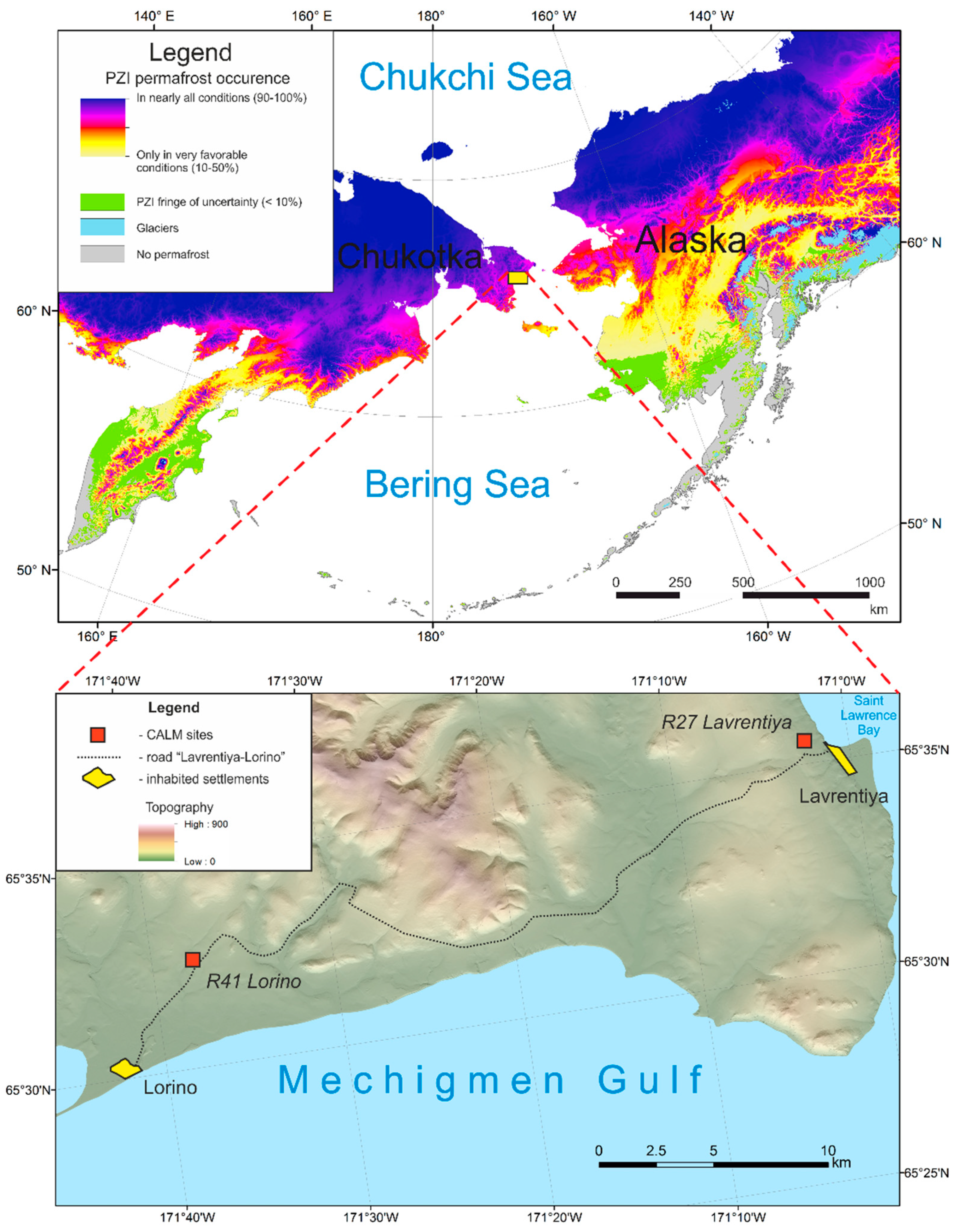
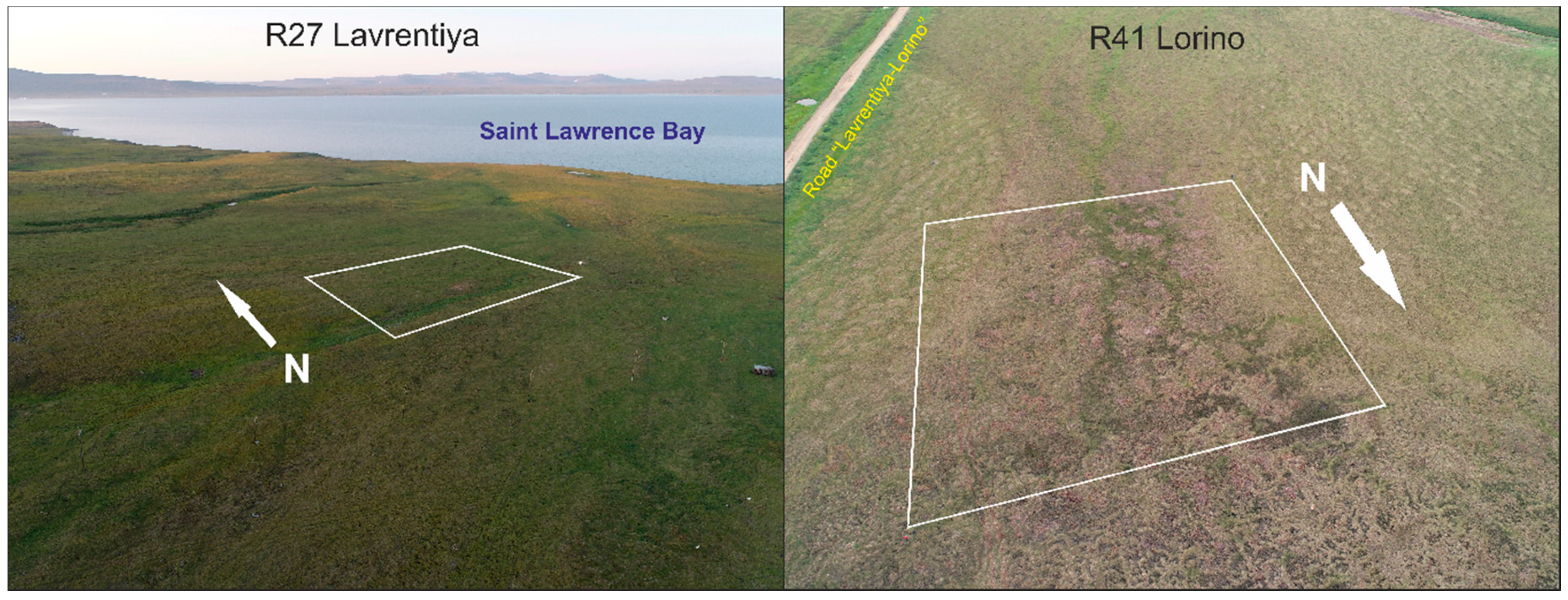
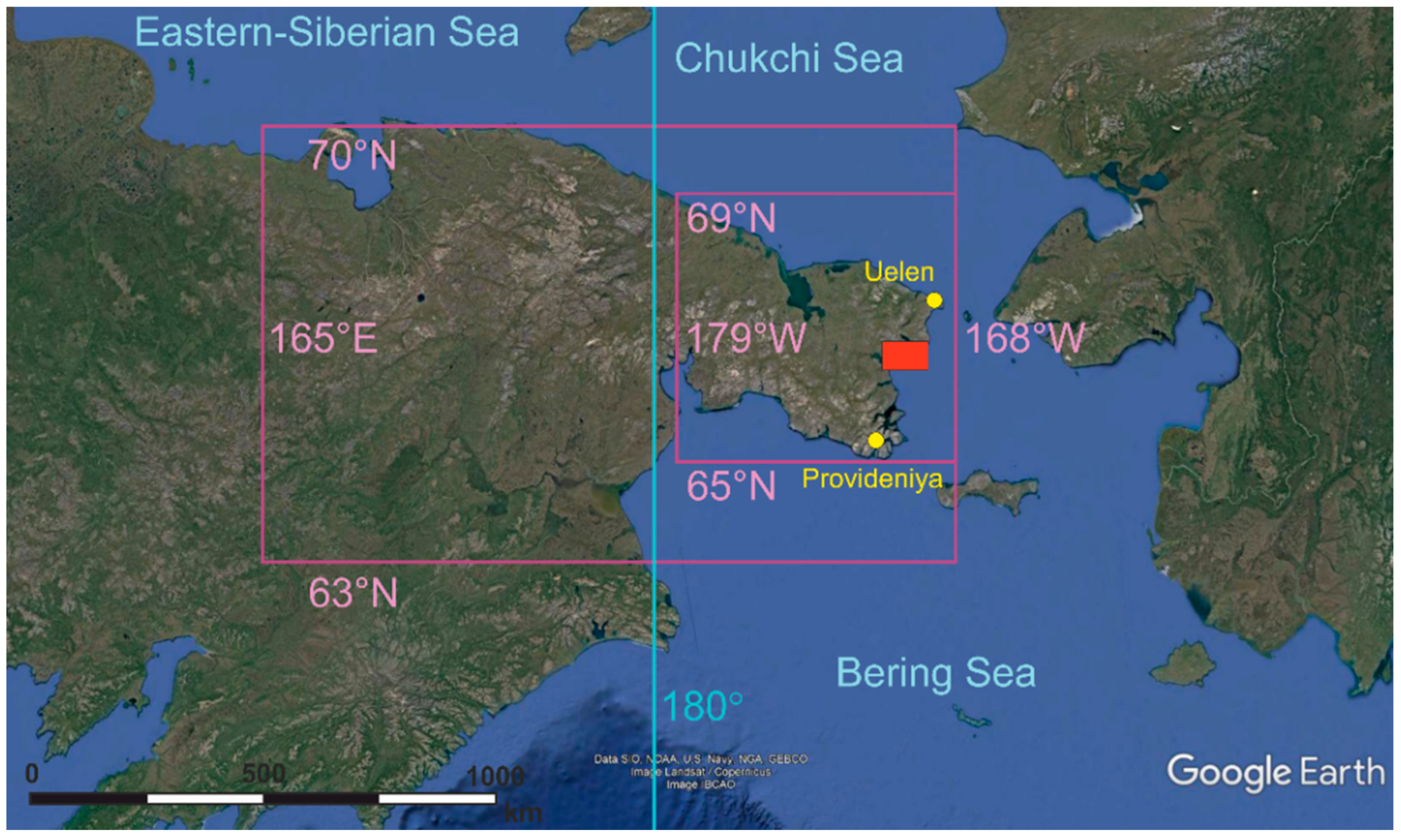
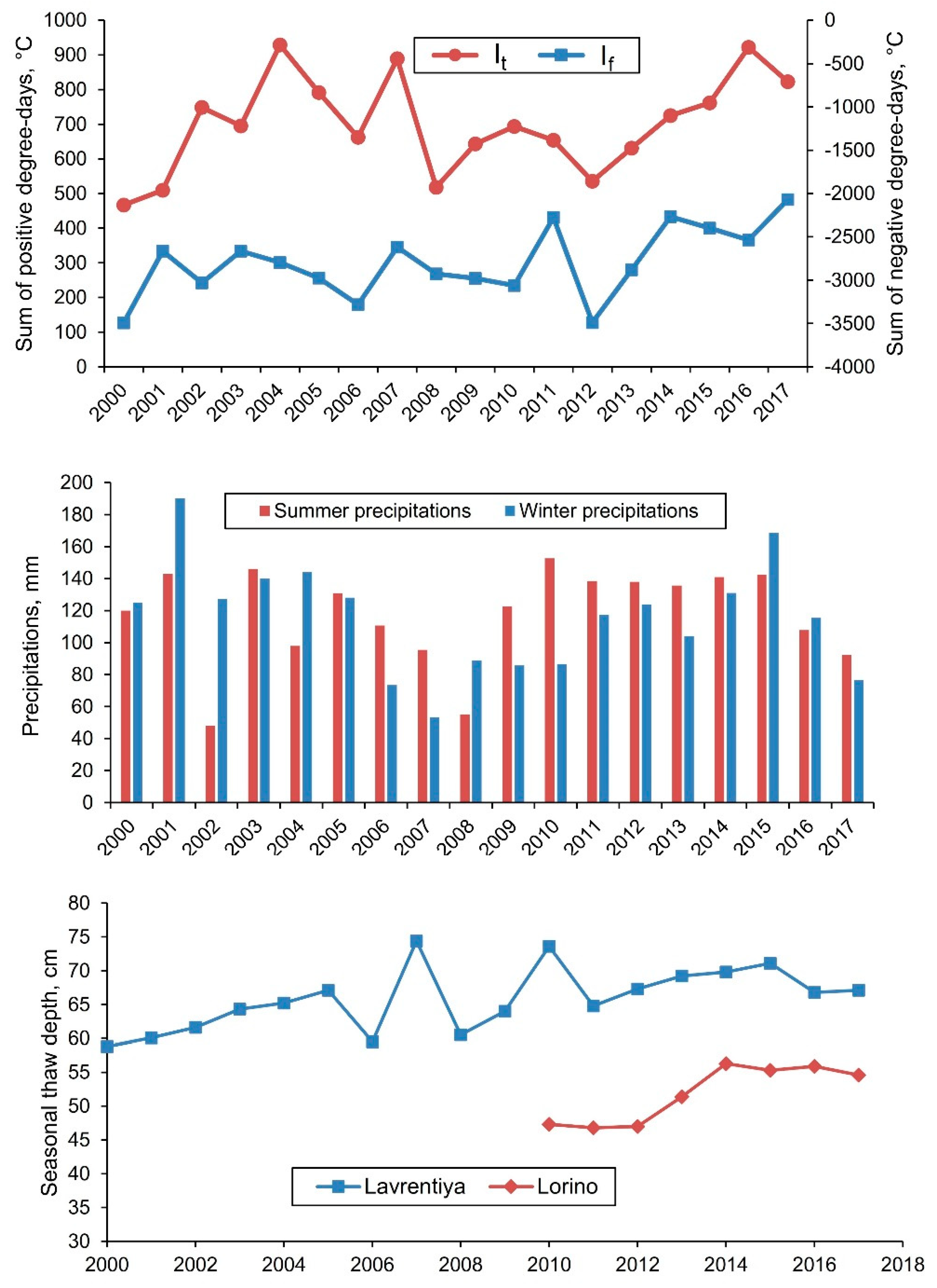
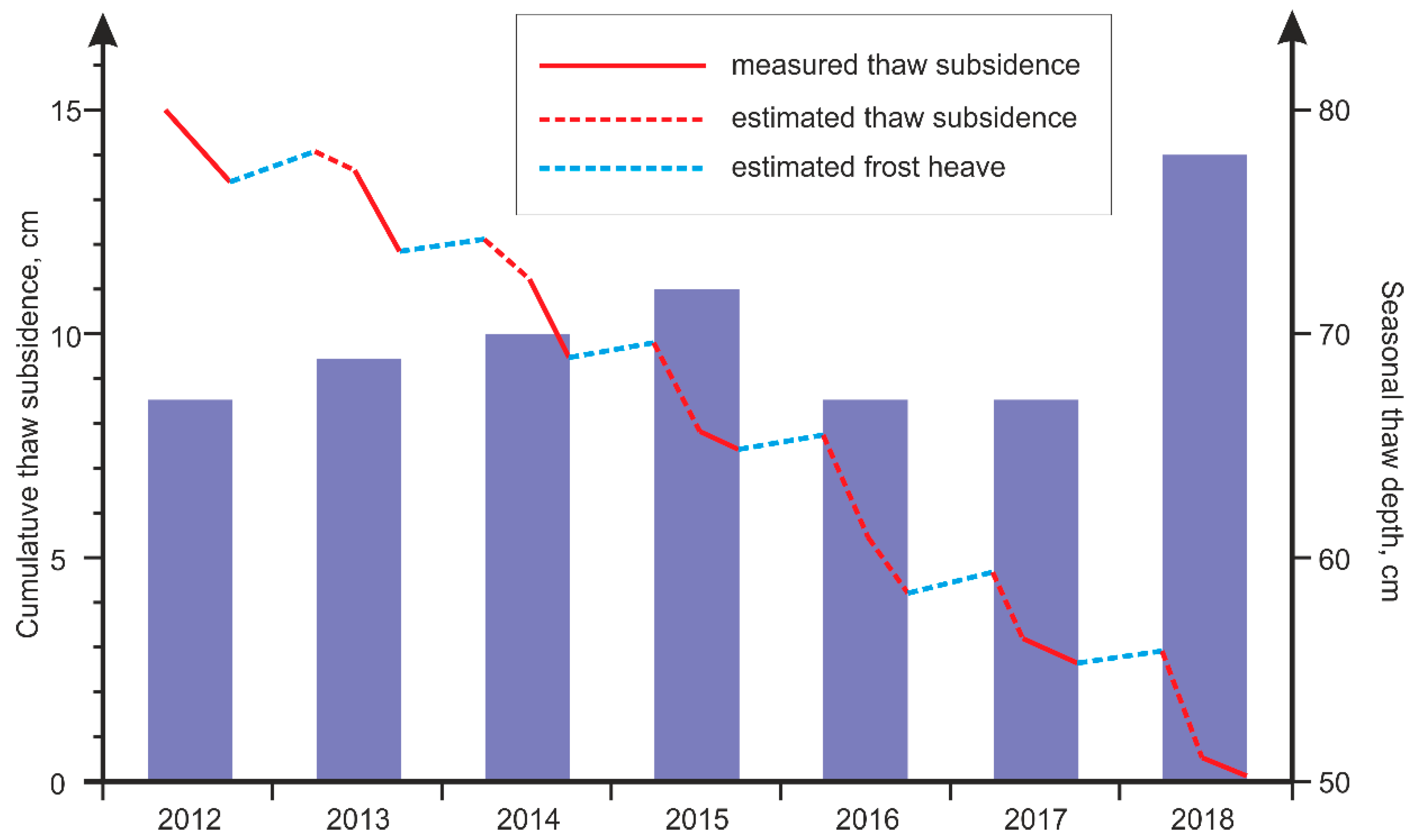
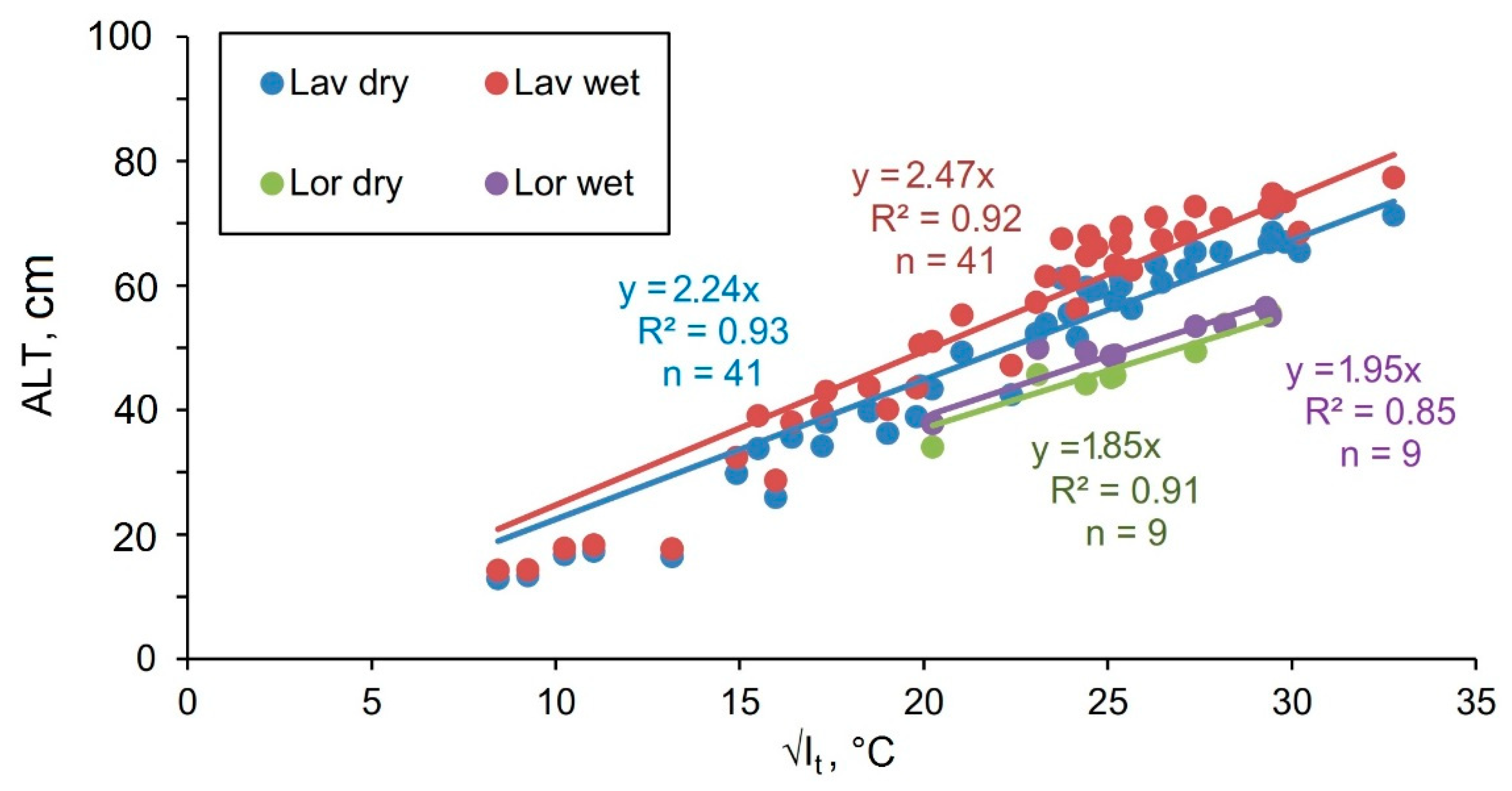
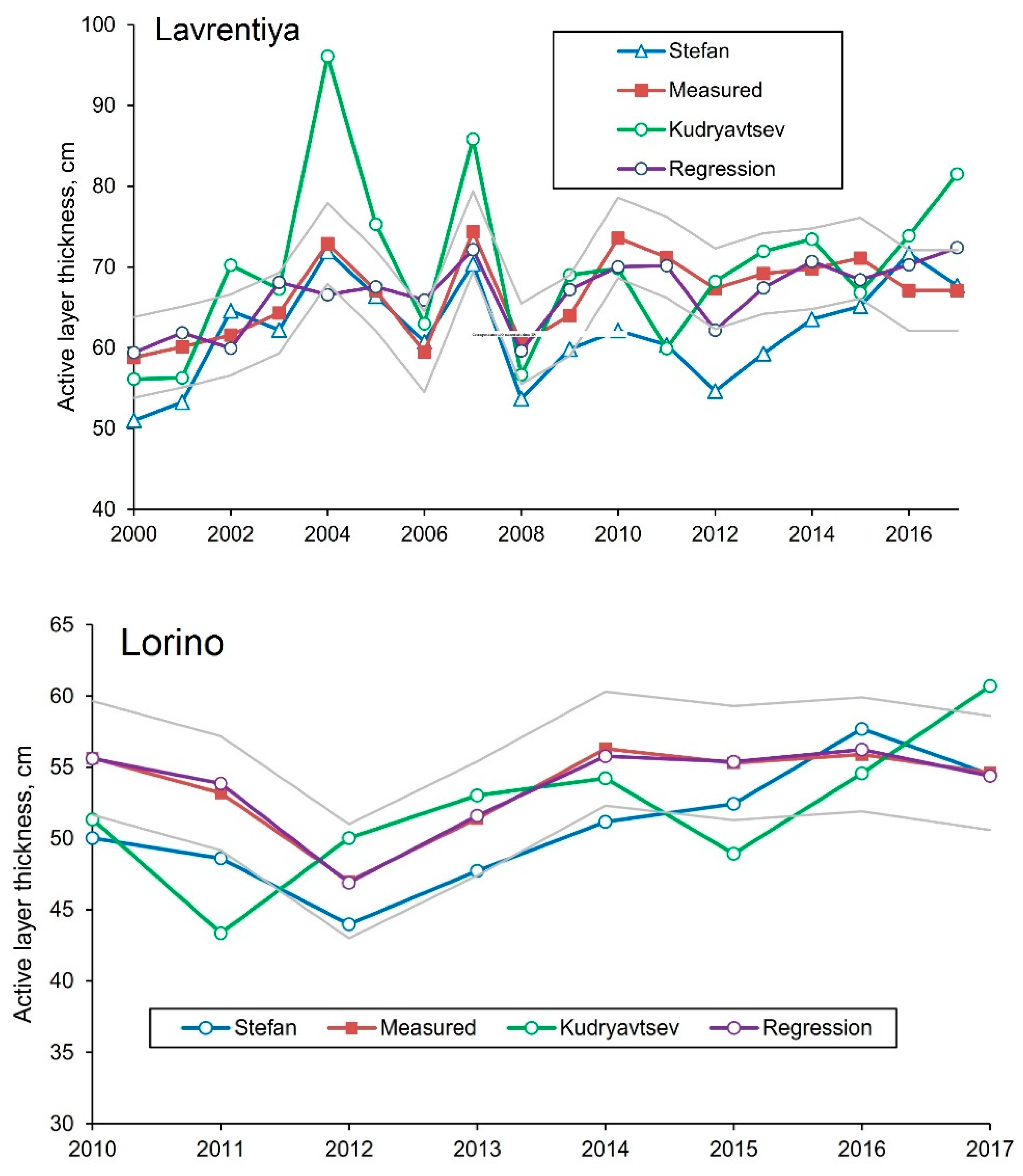
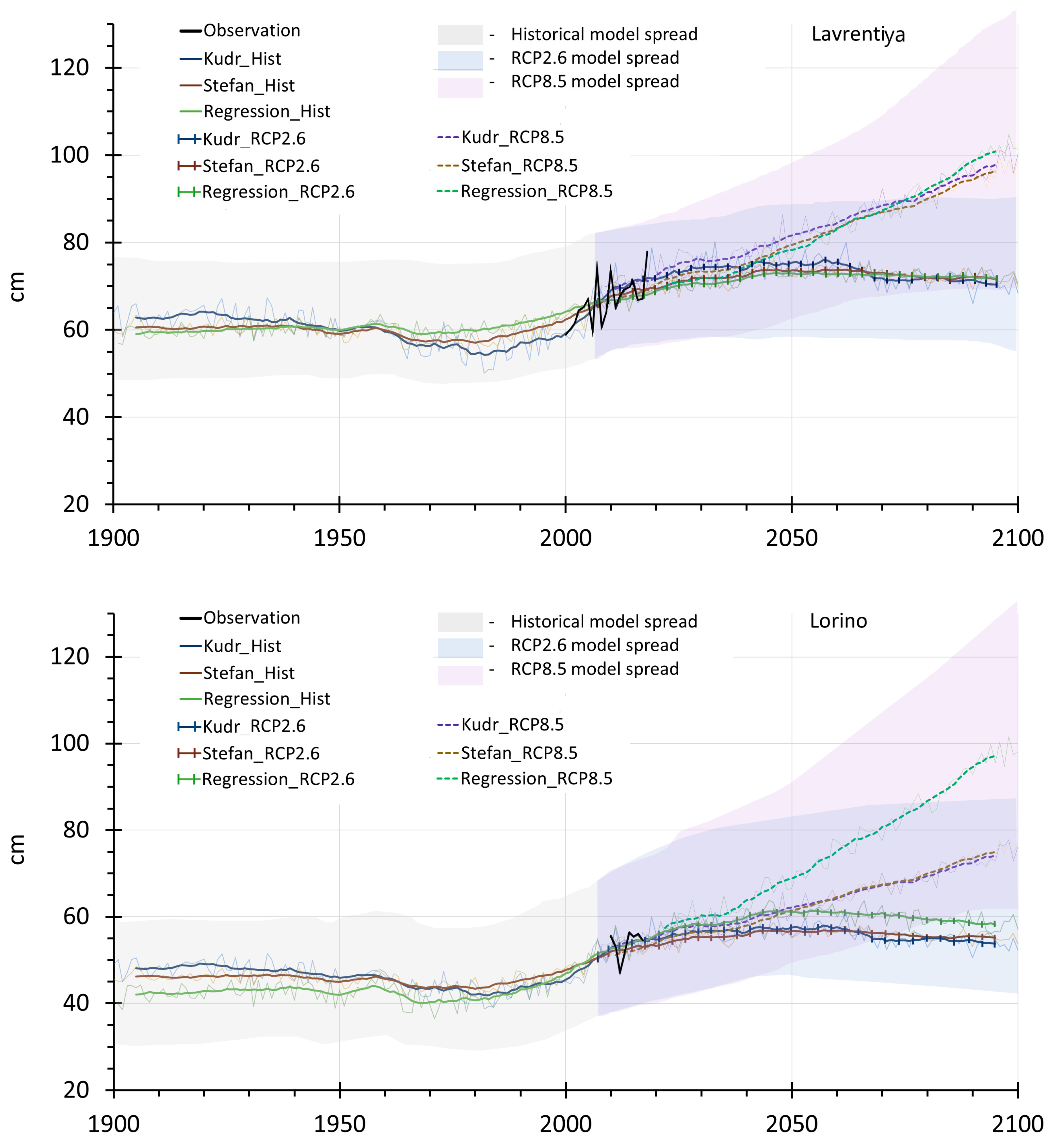

| Vegetation Unit | Area, sq. km | Area, % | Total % of the Arctic Area 1 |
|---|---|---|---|
| Non-carbonate mountain complex (B3) | 17,803.2 | 33.4 | 10.7 |
| Non-tussock sedge, dwarf-shrub, moss tundra (G3) | 874.7 | 1.6 | 11.3 |
| Tussock-sedge, dwarf-shrub, moss tundra (G4) | 8767.8 | 16.5 | 6.7 |
| Erect dwarf-shrub tundra (S1) | 5206.4 | 9.8 | 13.7 |
| Low-shrub tundra (S2) | 17,368.0 | 32.6 | 12.7 |
| Sedge, moss, dwarf-shrub wetland (W2) | 3248.6 | 6.1 | 2.7 |
| Total | 53,268.7 | 100.0 | 57.8 |
| Model | Horizontal Grid Resolution (Degrees) 1 | Country | Institution | ||
|---|---|---|---|---|---|
| at Latitude | at Longitude | ||||
| 1 | CNRM-CM5 | 1.40625 | 1.40625 | France | Centre National de Recherches Meteorologiques/Centre Europeen de Recherche et Formation Avancees en Calcul Scientifique |
| 2 | CSIRO-Mk3-6-0 | 1.875 | 1.875 | Australia | Commonwealth Scientific and Industrial Research Organisation in collaboration with the Queensland Climate Change Centre of Excellence |
| 3 | NOAA GFDL-CM3 | 2 | 2.5 | USA | Geophysical Fluid Dynamics Laboratory |
| 4 | GFDL-ESM2G | 2 | 2.5 | ||
| 5 | GFDL-ESM2M | 2 | 2.5 | ||
| 6 | IPSL-CM5A-LR | 1.875 | 3.75 | France | Institut Pierre-Simon Laplace |
| 7 | IPSL-CM5A-MR | 1.25874 | 2.5 | ||
| 8 | MIROC-ESM | 2.8125 | 2.8125 | Japan | Atmosphere and Ocean Research Institute (The University of Tokyo), National Institute for Environmental Studies, and Japan Agency for Marine-Earth Science and Technology |
| 9 | MIROC-ESM-CHEM | 2.8125 | 2.8125 | ||
| 10 | MIROC5 | 1.40625 | 1.40625 | ||
| 11 | MPI-ESM-LR | 1.875 | 1.875 | Germany | Max Planck Institute for Meteorology (MPI-M) |
| 12 | MPI-ESM-MR | 1.875 | 1.875 | ||
| 13 | MRI-CGCM3 | 1.125 | 1.125 | Japan | Meteorological Research Institute |
| 14 | NorESM1-M | 1.89474 | 2.5 | Norway | Norwegian Climate Centre |
| Model | Temperature | Precipitation Amount | |||||||
|---|---|---|---|---|---|---|---|---|---|
| DDF | DDT | Cold | Warm | ||||||
| Cell | Region | Cell | Region | Cell | Region | Cell | Region | ||
| 1 | CNRM-CM5 | 0.18 | 0.12 | 0.23 | 0.20 | 0.41 | 0.27 | 0.45 | 0.25 |
| 2 | CSIRO-Mk3-6-0 | 0.25 | 0.12 | 0.22 | 0.16 | 0.36 | 0.26 | 0.51 | 0.23 |
| 3 | GFDL-CM3 | 0.20 | 0.09 | 0.27 | 0.22 | 0.33 | 0.24 | 0.45 | 0.23 |
| 4 | GFDL-ESM2G | 0.17 | 0.09 | 0.21 | 0.16 | 0.28 | 0.24 | 0.35 | 0.24 |
| 5 | GFDL-ESM2M | 0.18 | 0.10 | 0.25 | 0.18 | 0.34 | 0.25 | 0.38 | 0.24 |
| 6 | IPSL-CM5A-LR | 0.16 | 0.09 | 0.29 | 0.20 | 0.34 | 0.27 | 0.50 | 0.26 |
| 7 | IPSL-CM5A-MR | 0.18 | 0.11 | 0.24 | 0.24 | 0.38 | 0.31 | 0.58 | 0.26 |
| 8 | MIROC-ESM | 0.17 | 0.10 | 0.29 | 0.20 | 0.37 | 0.26 | 0.47 | 0.31 |
| 9 | MIROC-ESM-CHEM | 0.15 | 0.10 | 0.31 | 0.19 | 0.36 | 0.29 | 0.56 | 0.25 |
| 10 | MIROC5 | 0.19 | 0.10 | 0.26 | 0.22 | 0.35 | 0.26 | 0.43 | 0.28 |
| 11 | MPI-ESM-LR | 0.17 | 0.11 | 0.27 | 0.27 | 0.28 | 0.28 | 0.45 | 0.24 |
| 12 | MPI-ESM-MR | 0.18 | 0.10 | 0.24 | 0.22 | 0.36 | 0.28 | 0.48 | 0.28 |
| 13 | MRI-CGCM3 | 0.17 | 0.12 | 0.23 | 0.16 | 0.37 | 0.29 | 0.46 | 0.29 |
| 14 | NorESM1-M | 0.20 | 0.11 | 0.25 | 0.20 | 0.28 | 0.26 | 0.37 | 0.24 |
| Ensemble | 0.12 | 0.07 | 0.20 | 0.14 | 0.25 | 0.22 | 0.33 | 0.20 | |
| Lavrentiya | Lorino | ||||
|---|---|---|---|---|---|
| Layer | Seasonal Thaw Depth, cm | Specific Thaw Subsidence, m·m−1 | Layer | Seasonal Thaw Depth, cm | Specific Thaw Subsidence, m·m−1 |
| 1 | 0–60 | 0.04 | 1 | 0–50 | 0.04 |
| 2 | 60–70 | 0.06 | 2 | 50–60 | 0.06 |
| 3 | >70 | 0.10 | 3 | >60 | 0.10 |
| Site | Equation Coefficients | Remainder | Approximation Coefficient (R2) | |||
|---|---|---|---|---|---|---|
| √It | Summer Precipitation | Winter Precipitation | √If | |||
| Lavrentiya | 0.79 | 0.08 | −0.06 | −0.49 | 69.2 | 0.67 |
| Lavrentiya dry | 1.18 | 0.08 | −0.05 | −0.13 | 34.9 | 0.59 |
| Lavrentiya wet | 0.82 | 0.07 | −0.04 | −0.31 | 60.8 | 0.59 |
| Lorino | 1.45 | 0.13 | −0.03 | −0.28 | 16.2 | 0.99 |
| Lorino dry | 1.68 | 0.12 | −0.02 | −0.29 | 9.1 | 0.89 |
| Lorino wet | 1.27 | 0.14 | −0.04 | −0.27 | 21.4 | 0.97 |
| Site | Average Volumetric Water Content Θ, % | Average Latent Heat ρL, MJ∙m−3 | Average Thermal Conductivity Kt, W∙m−1∙°C−1 | Heat Capacity Ct, MJ∙m−3∙°C−1 |
|---|---|---|---|---|
| Lavrentiya | 0.27 | 117.6 | 0.69 | 2.63 |
| Lorino | 0.40 | 140.7 | 0.51 | 3.40 |
| Model | Lavrentiya | Lorino | ||||
|---|---|---|---|---|---|---|
| Correspondence with Measured Values (R2) | p-Value | Maximal Difference, % | Correspondence with Measured Values (R2) | p-Value | Maximal Difference, % | |
| Regression | 0.67 | <0.001 | −9 + 11 | 0.99 | <0.001 | −1 + 1 |
| Stefan | 0.45 | 0.006 | −19 + 7 | 0.64 | 0.017 | −0 + 3 |
| Kudryavtsev | 0.43 | 0.004 | −16 + 32 | 0.36 | 0.116 | +7–−17 |
| CALM Site | Lavrentiya | Lorino | |||||
|---|---|---|---|---|---|---|---|
| Model | Reg | Ste | Kud | Reg | Ste | Kud | |
| Observed ALT | 66.5 | 52.4 | |||||
| 2025–2035 | RCP 2.6 | 69.3 (+4%) | 70.9 (+7%) | 78.5 (+18%) | 59.0 (+13%) | 57.1 (+9%) | 58.2 (+11%) |
| RCP 8.5 | 70.7 (+6%) | 72.5 (+9%) | 80.4 (+21%) | 60.7 (+17%) | 58.4 (+11%) | 59.5 (+14%) | |
| 2045–2055 | RCP 2.6 | 71.7 (+8%) | 72.6 (+9%) | 79.7 (+20%) | 62.0 (+18%) | 58.5 (+12%) | 59.1 (+13%) |
| RCP 8.5 | 77.1 (+16%) | 78.6 (+18%) | 86.0 (+29%) | 69.7 (+33%) | 63.2 (+21%) | 63.7 (+21%) | |
| 2090–2100 | RCP 2.6 | 70.5 (+6%) | 70.8 (+6%) | 74.7 (+12%) | 59.0 (+13%) | 57.0 (+9%) | 55.3 (+6%) |
| RCP 8.5 | 99.6 (+50%) | 95.5 (+43%) | 102.1 (+54%) | 98.0 (+87%) | 76.9 (+47%) | 75.7 (+45%) | |
© 2019 by the authors. Licensee MDPI, Basel, Switzerland. This article is an open access article distributed under the terms and conditions of the Creative Commons Attribution (CC BY) license (http://creativecommons.org/licenses/by/4.0/).
Share and Cite
Maslakov, A.; Shabanova, N.; Zamolodchikov, D.; Volobuev, V.; Kraev, G. Permafrost Degradation within Eastern Chukotka CALM Sites in the 21st Century Based on CMIP5 Climate Models. Geosciences 2019, 9, 232. https://doi.org/10.3390/geosciences9050232
Maslakov A, Shabanova N, Zamolodchikov D, Volobuev V, Kraev G. Permafrost Degradation within Eastern Chukotka CALM Sites in the 21st Century Based on CMIP5 Climate Models. Geosciences. 2019; 9(5):232. https://doi.org/10.3390/geosciences9050232
Chicago/Turabian StyleMaslakov, Alexey, Natalia Shabanova, Dmitry Zamolodchikov, Vasili Volobuev, and Gleb Kraev. 2019. "Permafrost Degradation within Eastern Chukotka CALM Sites in the 21st Century Based on CMIP5 Climate Models" Geosciences 9, no. 5: 232. https://doi.org/10.3390/geosciences9050232
APA StyleMaslakov, A., Shabanova, N., Zamolodchikov, D., Volobuev, V., & Kraev, G. (2019). Permafrost Degradation within Eastern Chukotka CALM Sites in the 21st Century Based on CMIP5 Climate Models. Geosciences, 9(5), 232. https://doi.org/10.3390/geosciences9050232






